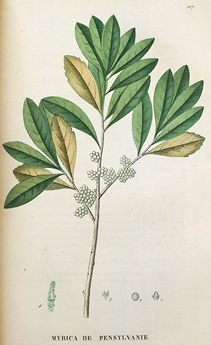Blazing Bayberry
By Audrey Stallsmith

I remember
The bayberry candles, frail flicker in the wolf-howling
Night. . .
from “America Remembers” by Paul Engle
When our power blinked out for several hours recently, I discovered that it takes about three candles to provide what I consider sufficient light for reading. Back in colonial days, when such waxy wicks were a perpetual and sometimes expensive necessity, I imagine people got by with one—or went to bed early!
The balsam-scented candles made from the wax of bayberries were less greasy than tallow tapers, and didn’t smoke when snuffed. So they got saved for special occasions—such as Christmas. These days, people burn those green candles—which can cost up to $12 each—during the holidays for good luck in the New Year.
Bayberry bushes come in both northern and southern varieties. The former (Myrica pensylvanica) is named for my state, while the latter (Myrica cerifera) means “wax-bearing.” The southern variety grows larger and produces smaller berries than the northern type.
To get those fruits you will need a male bush to pollinate your female ones. The male makes green catkins along its branches before the leaves appear in spring. Lacking sepals or petals, the female flowers are even more inconspicuous, being described as little bumps that eventually develop into the blue-black fruits. Those berries are so heavily coated with wax, however, that they appear gray.
The resilient, leathery-leaved bushes smell good year-round. Often found on the seashore, they reportedly tolerate drought, flooding, or salt with equanimity. Since they “fix” their own nitrogen from the soil, they seldom require fertilization. Only semi-evergreen in the north, they may drop most of their leaves during winter. Such defoliation, however, reveals their close-to-the-branches berries to the birds who feast on them during that season.
If you decide to go in for candle making, you’ll need to boil the berries to extract their wax, which floats on the surface of the water. That substance has also been used for sealing waxes and in soaps, but it can be brittle.
Native Americans drank a tea brewed from bayberry leaves to break fevers, and that astringent decoction was once used to clean sores and stop bleeding in such conditions as hemorrhages or dysentery too. The leaves have been substituted for bay leaves in cooking as well, though their flavor isn’t as strong.
However, bayberry has also served as an emetic, meaning that it is toxic enough to make you vomit if consumed in high doses. So I would leave the eating of it to the birds!
A nostalgic poem called "The Homestead" by John Greenleaf Whittier invites you to:
Come back to bayberry-scented slopes,
And fragrant fern and ground-nut vine;
Breathe airs blown over holt and copse
Sweet with black birch and pine.
Or, if you have no old homestead to return to this Christmas, you can burn a bayberry candle and pretend!
Myrica pensylvanica image is from Traité des Arbrisseaux et des Arbustes Cultivés en France et en Pleine, courtesy of the Missouri Botanical Garden.








